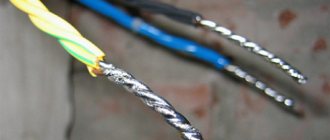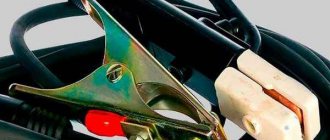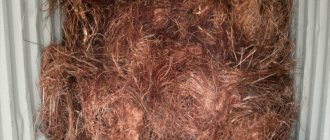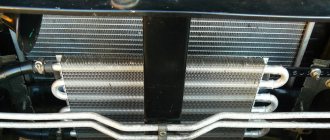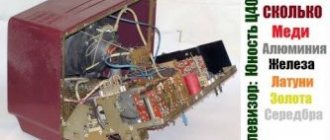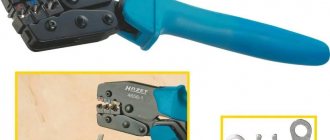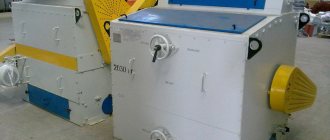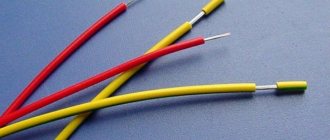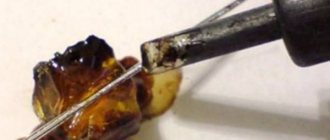Popular methods for stripping insulation
When handing over a cable, the metal core of the conductors is of value. Before going to the receiving point, you need to strip the cable from the insulating winding. There are several ways to do this yourself:
- manual stripping with a knife or hammer is a labor-intensive and time-consuming process, suitable if the batch of scrap is small;
- roasting and melting - a fast process, but harmful to the environment, not recommended for thin-stranded scrap, the metal burns out along with the winding;
- the use of special equipment is the fastest and safest method; tools are used during the work.
Cleaning with a knife or hammer
A construction or stationery knife or pullers with hooks, adjusting screws, etc. are suitable for stripping wires. When working, carefully cut the winding along the core, then take it to the side and cut it.
When working with a hammer, they hit the cable with force until the insulation separates from the metal.
Firing and reflow
You can burn raw materials over a fire, but the method is justified for large volumes of raw materials. Perform work outdoors, observing safety precautions.
Melting a cable with a soldering iron is one of the ways to remove insulation from thin and thick wires and cables. Before work, the wire is laid on a flat horizontal surface. Then heat up the soldering iron and apply it vertically to the winding. As the insulation melts, the cable is rotated around its axis. After firing, the plastic can be easily removed with pliers, tweezers, or pliers.
Important! Work in a well-ventilated area. When the insulation melts, toxins are released and there is a strong plastic smell.
Using a side cutter and stipper
How to quickly clean the cable for scrap delivery and mechanize the process? Special tools will help:
Side cutters are called wire cutters or tweezers for cutting wires. When using it, the free end of the wire is clamped between the blades, then carefully turned and pulled. The insulation is easily removed.
Note! The cutting edges are directed in the direction of movement of the tool so that the blades cut into the winding without much effort. If you handle the side cutter incorrectly, the cable will break off along with the insulation.
A stripper will help automate the cable cleaning process. There are different subtypes of the instrument. Models differ in the number of additional functions.
Stipper and working with it
The operating principle of all strippers is the same:
- the end of the cable is inserted into the hole of the tool;
- they clamp the handles of the stripper with their hands to cut through the windings;
- then the conductor is pulled outward, freeing it from insulation.
Important! The good thing about this tool is that it is simple and easy to use and is inexpensive. It rarely damages the cable, reduces winding removal time, and is suitable for working with single-core stranded conductors.
Special equipment
If there is a lot of scrap, special equipment for removing insulation will help simplify the preparation of raw materials. It can be rented directly from a centralized collection point.
Advantages and disadvantages of processing
An undeniable property of copper is its high electrical conductivity. It is used in construction and the manufacture of electrical equipment. The mechanical parameters of the metal are quite low, so it is not often used as a pure structural material.
Benefits of annealing:
- the treatment removes harmful substances from the metal and removes bacteria;
- the workpiece becomes soft and elastic, withstands pressure over 200 atmospheres;
- the material becomes resistant to corrosion;
- increase in hardness - the part can be bent several times without fear of cracks;
- reduction of residual stress during incomplete annealing.
There are significantly fewer disadvantages, but they still exist:
- the material requires slow cooling;
- copper is an expensive material;
- If handled incorrectly, soft metal can be damaged.
Recycling collection points
Scrap acceptors purchase the following waste cable and wire products:
a) manufacturing defects, warehouse surplus;
b) used cable lines, production remains;
c) old uncleaned cable;
d) dismantled communications;
e) installation waste.
Acceptance is carried out according to several criteria, which determine the price per kg of scrap. The length of the conductor pieces, the percentage of scrap to insulation, and foreign impurities are taken into account.
It is recommended to hand over recyclable materials to collection points that have documents and permits to conduct this type of activity. Before weighing, the scrap is inspected and assessed by specialists.
By the way! To determine the weight of the metal without winding, the acceptance specialist cuts off a prototype conductor, strips it and weighs it.
Sequencing
If necessary, you can obtain products for decorative or practical purposes at home. Melting copper at home, step-by-step instructions are as follows:
- The raw material is crushed and then placed in a crucible. It is worth considering that by reducing the size of pieces of metal, the melting process is significantly accelerated.
- After filling the crucible, it is placed in an oven, which is preheated.
- The molten alloy must be removed from the furnace using special pliers. Due to the active oxidation process, a homogeneous film may form on the surface. Before casting from copper, it must be removed.
- The metal is carefully poured into the prepared container. It is worth considering that if the straightened alloy gets into exposed areas of the body, serious injuries may occur. In addition, some materials may ignite upon contact. Therefore, extreme caution must be taken.
burn copper wires
It is very common in nature, found in a native state in many places in the Urals and Sweden, as well as in America near Lake Superior, Chile, Japan and China; nuggets weighing up to tons are found, as well as in many compounds. Cu OH 2. In reflected light, copper is bright red; in very thin sheets it appears green.
The specific gravity in the solid state varies greatly depending on the origin and processing: the specific gravity of natural copper crystals - cubes or octahedrons - is 8.94, electrolytic copper - 8.91, fused copper - 8, and forged copper - 8. Electrical conductivity of hard copper 99.95, and for soft, 21 for silver Copper does not change at ordinary temperatures and in dry air, but in humid air, especially in the presence of carbon dioxide, it becomes covered with a green coating, which includes basic carbon dioxide salts of copper.
When heated in air, copper becomes covered with a black coating of copper oxide, CuO. In the presence of acids, copper easily absorbs oxygen from the air and forms salts: thus, by dousing copper shavings on sloping tables with an aqueous solution of acetic acid, one obtains verdigris, or basic acetic-copper salt, 2 C 4 H 6 CuO 4 CuH 2 O 2 5H 2 O, etc.
Aqueous ammonia in the presence of oxygen dissolves copper. The resulting blue solution can dissolve fiber. Copper combines directly with sulfur, chlorine, bromine and iodine. The oxygen compounds of copper are the most famous and studied: Cu 2 O oxide and CuO oxide. In addition to them, two more higher oxidation states are recognized: CuO 2 dioxide and CuO 3 peroxide? Cuprous oxide occurs in the form of red copper ore. It is obtained by reducing copper oxide salts. If to a solution of copper sulfate, CuSO 4.
Acting on blue solutions of copper oxide salts with sulfurous, phosphorous acid, etc. Cuprous oxide salts are unstable and relatively easily turn into copper oxide salts.
Copper oxide salts are the most persistent; The most famous of them are: copper sulfate, or blue vitriol, CuSO 4 5H 2 O; when heated, it loses the elements of water and turns into white CuSO 4 powder, which greedily combines with water. Therefore, it is used to dehydrate wine alcohol.
Copper sulfate solutions are used for electroplating. Malachite represents the main copper carbonate, CuCO 3. Salts of copper oxide are capable of adding ammonia to themselves: thus, when ammonia is passed over anhydrous CuSO 4, a compound of the composition CuSO 4 is obtained.
In humid air, it gradually turns into compounds: Cu 8 O 4. For the extraction and technology of copper, see Copper ores. Cu OH 2], cuprite Cu 2 O, native copper. Of all these minerals, copper pyrite is the most common.
However, in most cases it is a primary mineral. Other copper-containing minerals, with few exceptions, originate from it as a result of various chemical reactions. Copper pyrite is found in close mixture with other sulfur minerals, especially often with pyrite, then with magnetic pyrite, lead luster and zinc blende.
Processing principle
Annealing is a heat treatment procedure for copper that produces a stable, strong metal structure, free from residual stresses. Annealing technology goes through several stages:
- Loading metal into equipment.
- Installing the muffle and purging with protective gas to remove air.
- Heating to 650–700 degrees.
- Rapid cooling up to 100 degrees when immersing the product in water.
- Giving the required shape.
- Reheat to 350–400 degrees.
- Air cooling and unloading.
The last stage of the technology is carried out twice as slow. The treatment ends when the annealing temperature of copper reaches a value at which it can be exposed to air without oxidation. It is prohibited to expose workpieces to high-temperature air. Duration: 1–2 hours.
How to Clean Insulated Copper Wire
It is very common in nature, found in a native state in many places in the Urals and Sweden, as well as in America near Lake Superior, Chile, Japan and China; nuggets weighing up to tons are found, as well as in many compounds. Cu OH 2. In reflected light, copper is bright red; in very thin sheets it appears green. The specific gravity in the solid state varies greatly depending on the origin and processing: the specific gravity of natural copper crystals - cubes or octahedrons - is 8.94, electrolytic copper - 8.91, fused copper - 8, and forged copper - 8. Electrical conductivity of hard copper 99.95, and for soft, 21 for silver
What equipment is used
Copper undergoes two types of heat treatment:
- annealing to reduce remaining stress;
- recrystallization annealing.
The temperature regime for recrystallization of oxygen-free copper is 200–240°C, and that of electrolytic copper is 180–230°C. Metal containing oxygen is treated in a neutral environment to reduce losses after oxidation.
For annealing heat treatment, a shaft-type convection oven is used. In addition, the equipment is in demand for annealing wire, rope, rods, steels, and metal balls.
The oven has the following advantages:
- improved accuracy of temperature control;
- automation of heat treatment;
- the fan at the bottom of the device ensures stable heat transfer;
- processing error is +/-5C;
- heating is carried out from electricity;
- ammonia and pure nitrogen protect the metal from oxidation;
- capacity - 8–36 tons;
- ease of operation and installation.
The furnace lid is equipped with a special pneumatic device, which is responsible for opening and closing during the annealing process. The emergency valve operates automatically when the pressure rises to high or drops to low.
extraction of copper from wires
VIDEO ON THE TOPIC: How to properly burn copper.
We started production according to my drawings. This installation, when modified, can process cables and wires, both copper and aluminum…. Video report from the Customer after 4 months of operation of the installation. This installation was the last one we made this spring. You can do... This horizontal installation, generally experimental, accommodated 16 passenger tires and received 40 liters of fuel.
Extraction of copper from wires. The easy way. Turn on subtitles! Burning copper wires without loss. The Big Showdown Theory. Extraction of copper from wires, how to remove insulation from a cable.
We supply a comprehensive range of Cat Copper Lan Cable Smoke. Unlike PVC cables and those made of other compounds that produce huge amounts of dense black smoke, toxic fumes and acid gases when exposed to fire, LSZH network cables produce very low levels of smoke and toxic fumes and no acid gases. Delivery time.
Areas of use
Cables with copper conductors are widely used in various sectors of human economic activity:
- in power lines serving for the transmission and distribution of electricity in stationary installations;
- installation of wiring inside residential premises and offices ;
- at production enterprises where there is a high probability of fires and explosions.
Single-core copper cable finds its use in conditions where, after installation, its immobility is ensured (electric motors, indoor electrical wiring).
At the same time, stranded wire is used to power equipment with a large range of motion.
Such equipment includes, for example, gantry cranes.
burn copper wires
It is very common in nature, found in a native state in many places in the Urals and Sweden, as well as in America near Lake Superior, Chile, Japan and China; nuggets weighing up to tons are found, as well as in many compounds. Cu OH 2. In reflected light, copper is bright red; in very thin sheets it appears green.
The specific gravity in the solid state varies greatly depending on the origin and processing: the specific gravity of natural copper crystals - cubes or octahedrons - is 8.94, electrolytic copper - 8.91, fused copper - 8, and forged copper - 8. Electrical conductivity of hard copper 99.95, and for soft, 21 for silver Copper does not change at ordinary temperatures and in dry air, but in humid air, especially in the presence of carbon dioxide, it becomes covered with a green coating, which includes basic carbon dioxide salts of copper.
When heated in air, copper becomes covered with a black coating of copper oxide, CuO. In the presence of acids, copper easily absorbs oxygen from the air and forms salts: thus, by dousing copper shavings on sloping tables with an aqueous solution of acetic acid, one obtains verdigris, or basic acetic-copper salt, 2 C 4 H 6 CuO 4 CuH 2 O 2 5H 2 O, etc.
Aqueous ammonia in the presence of oxygen dissolves copper. The resulting blue solution can dissolve fiber. Copper combines directly with sulfur, chlorine, bromine and iodine. The oxygen compounds of copper are the most famous and studied: Cu 2 O oxide and CuO oxide. In addition to them, two more higher oxidation states are recognized: CuO 2 dioxide and CuO 3 peroxide? Cuprous oxide occurs in the form of red copper ore. It is obtained by reducing copper oxide salts. If to a solution of copper sulfate, CuSO 4.
Acting on blue solutions of copper oxide salts with sulfurous, phosphorous acid, etc. Cuprous oxide salts are unstable and relatively easily turn into copper oxide salts.
Copper oxide salts are the most persistent; The most famous of them are: copper sulfate, or blue vitriol, CuSO 4 5H 2 O; when heated, it loses the elements of water and turns into white CuSO 4 powder, which greedily combines with water. Therefore, it is used to dehydrate wine alcohol.
Copper sulfate solutions are used for electroplating. Malachite represents the main copper carbonate, CuCO 3. Salts of copper oxide are capable of adding ammonia to themselves: thus, when ammonia is passed over anhydrous CuSO 4, a compound of the composition CuSO 4 is obtained.
In humid air, it gradually turns into compounds: Cu 8 O 4. For the extraction and technology of copper, see Copper ores. Cu OH 2], cuprite Cu 2 O, native copper. Of all these minerals, copper pyrite is the most common.
However, in most cases it is a primary mineral. Other copper-containing minerals, with few exceptions, originate from it as a result of various chemical reactions. Copper pyrite is found in close mixture with other sulfur minerals, especially often with pyrite, then with magnetic pyrite, lead luster and zinc blende.
Therefore, the most common copper ore is a mechanical mixture of pyrite and copper pyrite. But sulfur compounds are not very stable under the conditions prevailing on the earth’s surface. They more or less easily transform into oxide compounds. This kind of change occurs in the surface parts of sulfur copper ore deposits. If the upper part of the latter is located above the groundwater horizon, then three zones can be distinguished in them.
The upper zone represents the oxidation region. Here, sulfur metals, under the influence of O, CO 2 and atmospheric waters, turn into oxides and carbon dioxide compounds. Pyrite turns into hydrous iron oxides, mainly into limonite 2Fe 2 O 3. From copper pyrite, the same limonite and various oxidized copper-containing minerals are obtained: cuprite, azurite, malachite, chrysocolla.
It is very typical for this zone to have significant amounts of native copper as an intermediate product of the reactions taking place. Malachite is often found here in very large quantities.
Copper compounds are characterized by relatively significant solubility. Atmospheric waters leach them from here and carry them down. Thus, the surface parts of the deposit, located in the oxidation zone, are poorer in metal content. Often, almost only brown iron ore remains in this zone.
The copper compounds dissolved above penetrate downwards and begin to precipitate again, usually slightly above the groundwater horizon. Here is the second belt of the deposit - the cementation zone.
The ore content here is increased and sometimes very significant. The third belt of the deposit is represented by its slightly altered parts - this is the zone of normal primary ore. The most common copper ore deposits are vein deposits. Contact metamorphic deposits and deposits among sedimentary rocks are also common. Magmatic discharges, discharges from a molten fiery liquid volcanic mass as it cools, are much less common.
How to Clean Insulated Copper Wire
It is very common in nature, found in a native state in many places in the Urals and Sweden, as well as in America near Lake Superior, Chile, Japan and China; nuggets weighing up to tons are found, as well as in many compounds. Cu OH 2. In reflected light, copper is bright red; in very thin sheets it appears green. The specific gravity in the solid state varies greatly depending on the origin and processing: the specific gravity of natural copper crystals - cubes or octahedrons - is 8.94, electrolytic copper - 8.91, fused copper - 8, and forged copper - 8. Electrical conductivity of hard copper 99.95, and for soft, 21 for silver
What if you add a copper additive to your oil?
You can find these additives in a jar on sale. No approvals, no standards, no certificates. Everything is based on trust. At one's own risk. In my opinion, it is better not to experiment.
Any additive manufacturer always presents its products in the most favorable light. Typically, the emphasis is on improving several of the above characteristics of the oil, while the rest are supposedly “not worsened.” However, manufacturers of miracle potions based on copper often promise fuel savings of as much as 12%, an increase in power by the same amount, a reduction in noise by 18 dB (and that’s a lot!) and, most importantly, an increase in service life by 30 times! From these statements alone one can understand that either the Nobel Prize cannot find a laureate in any way, or it is all a fake.

